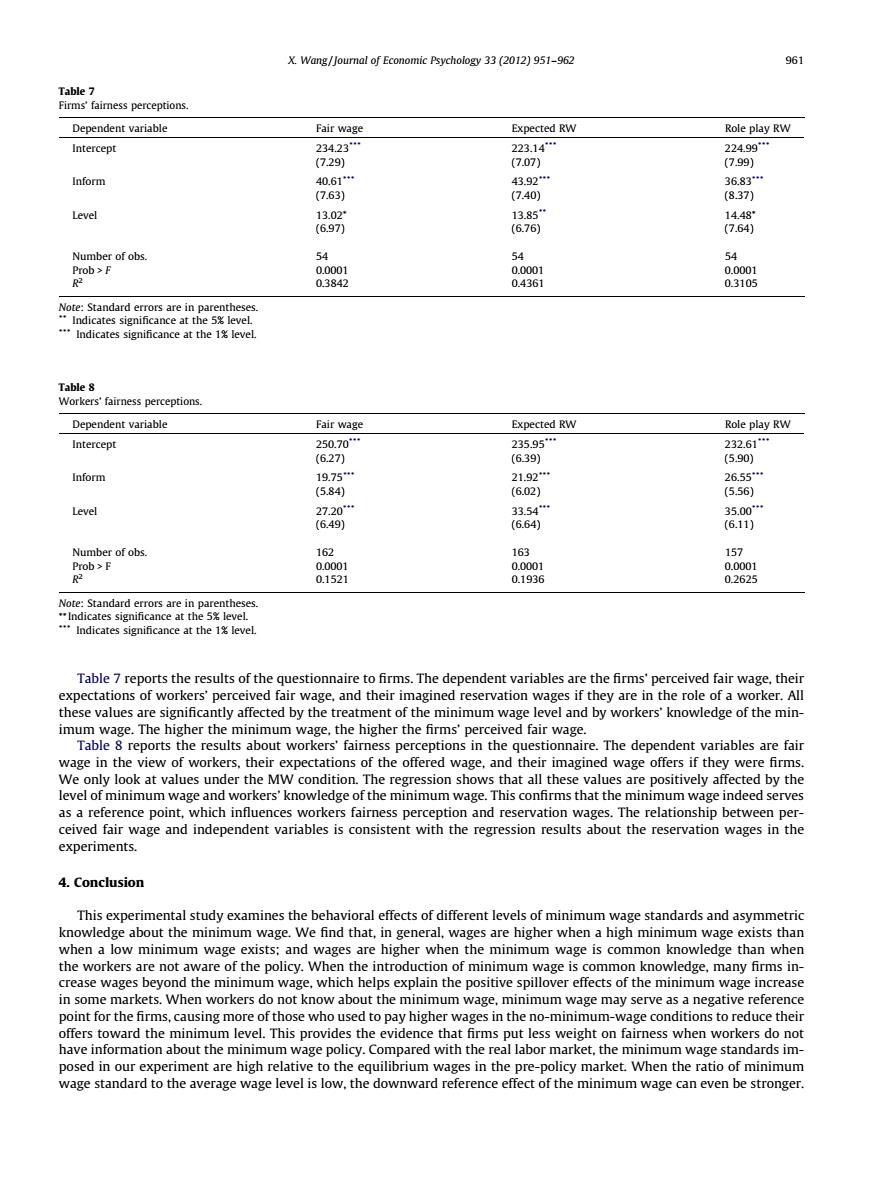正在加载图片...

X.Wang/Joumol of Economic Psychology 33 (2012)951-962 Dependent variable Fair wag Expected RW Role play RW Intercept inform 删 Level 1 断 s学is Dependent variable Fair wag Expected RW Role play RW Intercept Inform 55 Level 四 a9 a 品 品 Table 7 renc esults of the are the firms' these values a attected by the treat minmum wage level and by workersknowledge of the min- imTbe2gTeporstheresnsabouty sin the question naire.The dependent variables are fair ew workers, ions of the offered v ge,and their imagined wage offe ir th y were nrm as a ret reservaton wages experiments. 4.Conclusion This experimental study examines the behavioral effects of different levels of minimum wage standards and asymmetri um ts: and on knowledse than the workers are not a aware of the policy.Wh common know dge.many firms in in some markets.when workers do not know about the minimum wage.minimum wage may erve as a negative referenc point for the firms.causing more of those who used to pay higher wages in the no-minin ge conditions to reduce thei low.the e minimum wage can even be strongeTable 7 reports the results of the questionnaire to firms. The dependent variables are the firms’ perceived fair wage, their expectations of workers’ perceived fair wage, and their imagined reservation wages if they are in the role of a worker. All these values are significantly affected by the treatment of the minimum wage level and by workers’ knowledge of the minimum wage. The higher the minimum wage, the higher the firms’ perceived fair wage. Table 8 reports the results about workers’ fairness perceptions in the questionnaire. The dependent variables are fair wage in the view of workers, their expectations of the offered wage, and their imagined wage offers if they were firms. We only look at values under the MW condition. The regression shows that all these values are positively affected by the level of minimum wage and workers’ knowledge of the minimum wage. This confirms that the minimum wage indeed serves as a reference point, which influences workers fairness perception and reservation wages. The relationship between perceived fair wage and independent variables is consistent with the regression results about the reservation wages in the experiments. 4. Conclusion This experimental study examines the behavioral effects of different levels of minimum wage standards and asymmetric knowledge about the minimum wage. We find that, in general, wages are higher when a high minimum wage exists than when a low minimum wage exists; and wages are higher when the minimum wage is common knowledge than when the workers are not aware of the policy. When the introduction of minimum wage is common knowledge, many firms increase wages beyond the minimum wage, which helps explain the positive spillover effects of the minimum wage increase in some markets. When workers do not know about the minimum wage, minimum wage may serve as a negative reference point for the firms, causing more of those who used to pay higher wages in the no-minimum-wage conditions to reduce their offers toward the minimum level. This provides the evidence that firms put less weight on fairness when workers do not have information about the minimum wage policy. Compared with the real labor market, the minimum wage standards imposed in our experiment are high relative to the equilibrium wages in the pre-policy market. When the ratio of minimum wage standard to the average wage level is low, the downward reference effect of the minimum wage can even be stronger. Table 7 Firms’ fairness perceptions. Dependent variable Fair wage Expected RW Role play RW Intercept 234.23*** 223.14*** 224.99*** (7.29) (7.07) (7.99) Inform 40.61*** 43.92*** 36.83*** (7.63) (7.40) (8.37) Level 13.02⁄ 13.85** 14.48⁄ (6.97) (6.76) (7.64) Number of obs. 54 54 54 Prob > F 0.0001 0.0001 0.0001 R2 0.3842 0.4361 0.3105 Note: Standard errors are in parentheses. ** Indicates significance at the 5% level. *** Indicates significance at the 1% level. Table 8 Workers’ fairness perceptions. Dependent variable Fair wage Expected RW Role play RW Intercept 250.70*** 235.95*** 232.61*** (6.27) (6.39) (5.90) Inform 19.75*** 21.92*** 26.55*** (5.84) (6.02) (5.56) Level 27.20*** 33.54*** 35.00*** (6.49) (6.64) (6.11) Number of obs. 162 163 157 Prob > F 0.0001 0.0001 0.0001 R2 0.1521 0.1936 0.2625 Note: Standard errors are in parentheses. ⁄⁄ Indicates significance at the 5% level. *** Indicates significance at the 1% level. X. Wang / Journal of Economic Psychology 33 (2012) 951–962 961